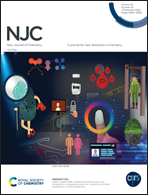Ultrasound-assisted diversion of nitrobenzene derivatives to their aniline equivalents through a heterogeneous magnetic Ag/Fe3O4-IT nanocomposite catalyst†
Abstract
A heterogeneous magnetic catalytic system is fabricated and suitably applied for the fast and direct conversion of nitrobenzene (NB) derivatives to their aniline forms. For this purpose, different conditions and methods have been checked with numerous catalytic amounts of the nanocatalyst composite, which was constructed of iron oxide and silver nanoparticles and possessed an isothiazolone organic structure. Herein, the mechanistic aspect of the catalytic functioning of this highly efficient nanocatalyst is highlighted and discussed. Firstly, a convenient preparation route assisted by ultrasonication for this metal and metal oxide nanocomposite is presented. Further, a fast and direct reduction strategy for NBs is investigated using ultrasound irradiation (50 kHz, 200 W L−1). As two great advantages of this catalyst, high magnetic property and excellent reusability are also mentioned. This report well reveals that a really convenient conversion of NBs to anilines can be achieved with a high yield during the rapid reaction time in presence of mild reaction conditions.



 Please wait while we load your content...
Please wait while we load your content...